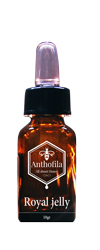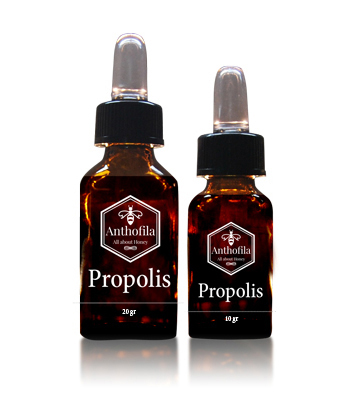| Pine Honey |
 |
|
Pine honey is collected throughout the dense pine forests of Central Makedonia, Halkidiki and Evia.
Characteristically, pine honey is a dense, viscous honey with a rich aroma. Having less calories than pollen honey, it is often the honey of choice as a result.
Approximately 65% of the total Greek honey production is pine honey.
Spring pine honey often has hints of chamomile and vanilla as the bees have a mind of their own and take advantage of other available flora in the region.
Anthofila pine honey is non-pasteurized and due to the most gentle of filtration techniques, beneficial properties are maintained. |
| Flower Honey |
 |
|
Using their expert knowledge and experience, Anthofila’s beekeepers, strategically place their hives in the vicinity of Greece’s diverse flora and moving them regularly to take advantage of the seasons plethora of flowers. The bees then do what comes naturally, they select the sweetest pollen from various flowers to produce an irresistible, aromatic honey.
Flower honey has a smooth texture, light colour and the wonderful natural infusion of various flower aromas that can stimulate the senses of the most demanding customer.
Anthofila flower honey is non-pasteurized and due to the most gentle of filtration techniques, beneficial properties are maintained.
|
| Pine-Flower honey of Thasos |
 |
|
Pine-Flower honey of Thasos, as the name suggests, is predominately gathered in Spring from the beautiful island of Thasos. The unique balance of flora and forests of Thasos contribute to this special honey, combining the rich taste and benefits of pine honey with light hints of regional flowers, in a way that only the bees can and do. Anthofila Pine-Flower honey of Thasos is non-pasteurized and due to the most gentle of filtration techniques, beneficial properties are maintained. Anthofila Pine-Flower honey of Thasos benefits.
|
| Chestnut honey |
 |
|
Chestnut honey is collected from mountainous areas of Macedonia which due to the altitude maintain flowering until late in summer. Chestnut honey coexists at that time together with Linden and mountain herbs including mint, mountain tea and mullein. Each gives the honey its own aroma, dominated with Chestnut and Linden with a hint of mint that lingers deep on the palate.
This exceptional honey is rich in every aspect, full distinctive flavor, dark in colour and very aromatic.
Anthofila Chestnut honey is non-pasteurized and due to the most gentle of filtration techniques, beneficial properties are maintained.
|
| Heather honey |
 |
|
Heather honey is gathered in autumn after our bees have worked the abundant heather which is considered to be a treat for them.
|
| Pollen |
 |
|
Pollen is the dust that bees collect in their legs during their daily foraging from flower to flower. It is the "seed" of plants and contains all the ingredients which a new shoot needs in order to start its course at becoming plant. The transfer of pollen from plant to plant is a method of plant reproduction. The bee, of course, does not make this consciously but its purpose is to mix honey with pollen for the development of their offspring. Pollen is pure and unprocessed. Ancient Greeks called it ‘life-giving dust’. It contains all the ingredients that a body needs in its everyday life. Its composition depends on its plant origin. Its major components comprise of protein, fat, carbohydrates, carbon, mineral materials, vitamins, trace elements, growth and antibiotic substances as well as ingredients which function as hormones. Pollen is best consumed by 2 tablespoons a day, neat or in juice or milk before meals. In some cases, bee pollen may cause gastrointestinal disturbance or an allergic reaction. Small doses to begin with are advisable. This product may cause an allergic reaction particularly in people allergic to bees and bee products. |
| Royal jelly |
 |
|
Royal jelly is considered an elixir of health and youth, and for good reason since it is a "bomb" of valuable components. Just a small amount, under the tongue, is more than enough of a dose of this original superfood. |
| Propolis |
 |
|
Propolis (bee-glue) is a sticky substance produced by bees, which results from the collection of resinous exudate from barks of plants, and which is enriched with wax, pollen, enzymes and other substances. Propolis is used by bees to seal and disinfect the inside of the beehive. The healing properties of propolis have been known since ancient times, during which they are referred to as "black wax". People who thrived on the Mediterranean coast, were using propolis as a medicine, since they had found the anti-inflammatory action. Hippocrates recommended it for the spreading of ulcers and burns. Roman soldiers in their military campaigns always had in their luggage propolis, while the Egyptians used it for embalming. Today propolis is widely used as a medicine, either as unchanged composition, or as a component of other formulations. The main research documented properties of propolis are: Anti-inflammatory action, anti-viral properties, antifungal properties, Antioxidant effect, Immune activity, antihistamine activity. Propolis is applied to the skin. This product may cause an allergic reaction particularly in people allergic to bees and bee products. It should not be used 2 weeks before surgery, during pregnancy or breastfeeding. Asthma sufferers should also avoid using this product. |




